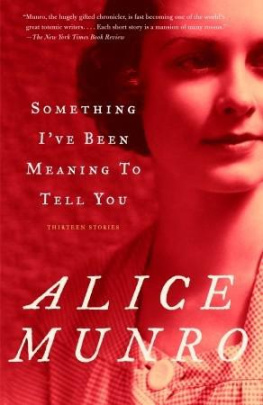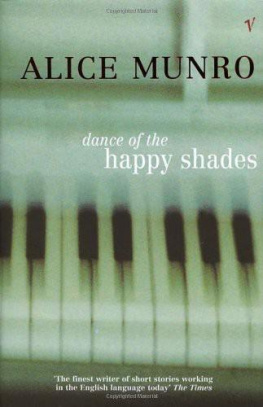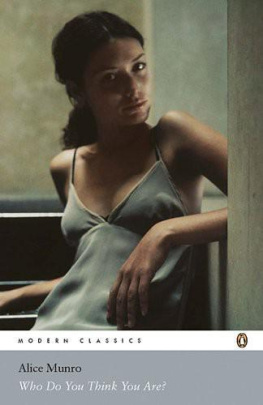Alice Munro - The Love Of A Good Woman
Here you can read online Alice Munro - The Love Of A Good Woman full text of the book (entire story) in english for free. Download pdf and epub, get meaning, cover and reviews about this ebook. genre: Prose. Description of the work, (preface) as well as reviews are available. Best literature library LitArk.com created for fans of good reading and offers a wide selection of genres:
Romance novel
Science fiction
Adventure
Detective
Science
History
Home and family
Prose
Art
Politics
Computer
Non-fiction
Religion
Business
Children
Humor
Choose a favorite category and find really read worthwhile books. Enjoy immersion in the world of imagination, feel the emotions of the characters or learn something new for yourself, make an fascinating discovery.

- Book:The Love Of A Good Woman
- Author:
- Genre:
- Rating:4 / 5
- Favourites:Add to favourites
- Your mark:
- 80
- 1
- 2
- 3
- 4
- 5
The Love Of A Good Woman: summary, description and annotation
We offer to read an annotation, description, summary or preface (depends on what the author of the book "The Love Of A Good Woman" wrote himself). If you haven't found the necessary information about the book — write in the comments, we will try to find it.
The Love Of A Good Woman — read online for free the complete book (whole text) full work
Below is the text of the book, divided by pages. System saving the place of the last page read, allows you to conveniently read the book "The Love Of A Good Woman" online for free, without having to search again every time where you left off. Put a bookmark, and you can go to the page where you finished reading at any time.
Font size:
Interval:
Bookmark:

Alice Munro
The Love Of A Good Woman
First published in 1998
For Ann Close
My valued editor
and constant friend
AUTHORS NOTE
For certain expert information essential to these stories, my thanks to Ruth Roy, Mary Carr, and D. C. Coleman. And for his inspired and ingenious research on many occasions, I thank Reg Thompson.
Stories included in this collection that were previously published in The New Yorker appeared there in very different form.
The Love Of A Good Woman
For the last couple of decades, there has been a museum in Walley, dedicated to preserving photos and butter churns and horse harnesses and an old dentists chair and a cumbersome apple peeler and such curiosities as the pretty little porcelain-and-glass insulators that were used on telegraph poles.
Also there is a red box, which has the letters d. m. willens, optometrist printed on it, and a note beside it, saying, This box of optometrists instruments though not very old has considerable local significance, since it belonged to Mr. D. M. Willens, who drowned in the Peregrine River, 1951. It escaped the catastrophe and was found, presumably by the anonymous donor, who dispatched it to be a feature of our collection.
The ophthalmoscope could make you think of a snowman. The top part, that is-the part thats fastened onto the hollow handle. A large disk, with a smaller disk on top. In the large disk a hole to look through, as the various lenses are moved. The handle is heavy because the batteries are still inside. If you took the batteries out and put in the rod that is provided, with a disk on either end, you could plug in an electric cord. But it might have been necessary to use the instrument in places where there wasnt any electricity.
The retinoscope looks more complicated. Underneath the round forehead clamp is something like an elfs head, with a round flat face and a pointed metal cap. This is tilted at a forty-five-degree angle to a slim column, and out of the top of the column a tiny light is supposed to shine. The flat face is made of glass and is a dark sort of mirror.
Everything is black, but that is only paint. In some places where the optometrists hand must have rubbed most often, the paint has disappeared and you can see a patch of shiny silver metal.
i. jutlandThis place was called Jutland. There had been a mill once, and some kind of small settlement, but that had all gone by the end of the last century, and the place had never amounted to much at any time. Many people believed that it had been named in honor of the famous sea battle fought during the First World War, but actually everything had been in ruins years before that battle ever took place.
The three boys who came out here on a Saturday morning early in the spring of 1951 believed, as most children did, that the name came from the old wooden planks that jutted out of the earth of the riverbank and from the other straight thick boards that stood up in the nearby water, making an uneven palisade. (These were in fact the remains of a dam, built before the days of cement.) The planks and a heap of foundation stones and a lilac bush and some huge apple trees deformed by black knot and the shallow ditch of the millrace that filled up with nettles every summer were the only other signs of what had been here before.
There was a road, or a track, coming back from the township road, but it had never been gravelled, and appeared on the maps only as a dotted line, a road allowance. It was used quite a bit in the summer by people driving to the river to swim or at night by couples looking for a place to park. The turnaround spot came before you got to the ditch, but the whole area was so overrun by nettles, and cow parsnip, and woody wild hemlock in a wet year, that cars would sometimes have to back out all the way to the proper road.
The car tracks to the waters edge on that spring morning were easy to spot but were not taken notice of by these boys, who were thinking only about swimming. At least, they would call it swimming; they would go back to town and say that they had been swimming at Jutland before the snow was off the ground.
It was colder here upstream than on the river flats close to the town. There was not a leaf out yet on the riverbank trees-the only green you saw was from patches of leeks on the ground and marsh marigolds fresh as spinach, spread along any little stream that gullied its way down to the river. And on the opposite bank under some cedars they saw what they were especially looking for-a long, low, stubborn snowbank, gray as stones.
Not off the ground.
So they would jump into the water and feel the cold hit them like ice daggers. Ice daggers shooting up behind their eyes and jabbing the tops of their skulls from the inside. Then they would move their arms and legs a few times and haul themselves out, quaking and letting their teeth rattle; they would push their numb limbs into their clothes and feel the painful recapture of their bodies by their startled blood and the relief of making their brag true.
The tracks that they didnt notice came right through the ditch-in which there was nothing growing now, there was only the flat dead straw-colored grass of the year before. Through the ditch and into the river without trying to turn around. The boys tramped over them. But by this time they were close enough to the water to have had their attention caught by something more extraordinary than car tracks.
There was a pale-blue shine to the water that was not a reflection of sky. It was a whole car, down in the pond on a slant, the front wheels and the nose of it poking into the mud on the bottom, and the bump of the trunk nearly breaking the surface. Light blue was in those days an unusual color for a car, and its bulgy shape was unusual, too. They knew it right away. The little English car, the Austin, the only one of its kind surely in the whole county. It belonged to Mr. Willens, the optometrist. He looked like a cartoon character when he drove it, because he was a short but thick man, with heavy shoulders and a large head. He always seemed to be crammed into his little car as if it was a bursting suit of clothes.
The car had a panel in its roof, which Mr. Willens opened in warm weather. It was open now. They could not see very well what was inside. The color of the car made its shape plain in the water, but the water was really not very clear, and it obscured what was not so bright. The boys squatted down on the bank, then lay on their stomachs and pushed their heads out like turtles, trying to see. There was something dark and furry, something like a big animal tail, pushed up through the hole in the roof and moving idly in the water. This was shortly seen to be an arm, covered by the sleeve of a dark jacket of some heavy and hairy material. It seemed that inside the car a mans body-it had to be the body of Mr. Willens-had got into a peculiar position. The force of the water-for even in the millpond there was a good deal of force in the water at this time of year-must have somehow lifted him from the seat and pushed him about, so that one shoulder was up near the car roof and one arm had got free. His head must have been shoved down against the drivers door and window. One front wheel was stuck deeper in the river bottom than the other, which meant that the car was on a slant from side to side as well as back to front. The window in fact must have been open and the head sticking out for the body to be lodged in that position. But they could not get to see that. They could picture Mr. Willenss face as they knew it-a big square face, which often wore a theatrical sort of frown but was never seriously intimidating. His thin crinkly hair was reddish or brassy on top, and combed diagonally over his forehead. His eyebrows were darker than his hair, thick and fuzzy like caterpillars stuck above his eyes. This was a face already grotesque to them, in the way that many adult faces were, and they were not afraid to see it drowned. But all they got to see was that arm and his pale hand. They could see the hand quite plain once they got used to looking through the water. It rode there tremulously and irresolutely, like a feather, though it looked as solid as dough. And as ordinary, once you got used to its being there at all. The fingernails were all like neat little faces, with their intelligent everyday look of greeting, their sensible disowning of their circumstances.
Next pageFont size:
Interval:
Bookmark:
Similar books «The Love Of A Good Woman»
Look at similar books to The Love Of A Good Woman. We have selected literature similar in name and meaning in the hope of providing readers with more options to find new, interesting, not yet read works.
Discussion, reviews of the book The Love Of A Good Woman and just readers' own opinions. Leave your comments, write what you think about the work, its meaning or the main characters. Specify what exactly you liked and what you didn't like, and why you think so.












